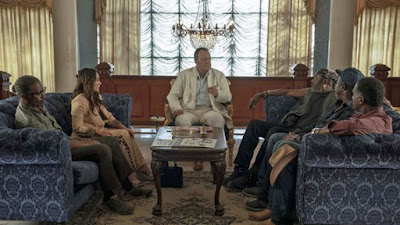Opening in modern times, Da 5 Bloods is about four African-American Vietnam War vets who return to Vietnam as older adults on a mission to find the remains of their fallen squad leader Norman (Chadwick Boseman), and also to locate a buried chest of gold bars that they left behind during the war. The four veterans are Paul (Delroy Lindo), Melvin (Isiah Whitlock Jr.), Otis (Clarke Peters), and Eddie (Norm Lewis), and the main focus of the film is on Paul and his inability to completely resolve his post-traumatic stress disorder from after the war. Paul's estranged college aged son David (Jonathan Majors) joins the squad on their journey, along with Vinh (Johnny Tri Nguye), their Vietnamese guide.
One of the most important aspects of Da 5 Bloods is Lee's decision to cast minorities (African-Americans as well as Asians) in leading roles. There's the aforementioned African-American leads, who all give powerfully nuanced performances, but there's also the Asian roles that Lee gives important roles to. Throughout the film, Lee cuts to Hanoi Hannah (Van Veronica Ngo), a disc jokey who uses her radio show to voice her support for the African-American soldiers fighting in Vietnam. Otis visits his former girlfriend Tien (Le Y Lan), a savvy and successful businesswoman, who it is revealed has a now adult daughter with Otis. The guide Vinh is portrayed as a strong and confident man who provides a steady hand for the squad during their journey.
By doing this, Lee is showing the interconnected cultural and at times personal (Otis, Tien, and their mixed-race daughter) connections between both African-Americans and Vietnamese. Both of these races were caught in an American-led conflict that sought to oppress them and destroy their lives. Da 5 Bloods, with its portraits of minority characters trying to rebuild their lives after the devastating Vietnam war, is Lee's attempt to empower those who were formerly forgotten and exploited by colonialist and imperialist forces.
The Vietnam war was ultimately an American venture that was supported by French colonialist, who viewed Vietnam as being a country they wanted to conquer for their own. This aspect of the war is cleverly symbolized by the character of Desroche (Jean Reno), a morally shady French businessman who has volunteered to help the soldiers to illegally export their buried treasure safely out of Vietnam, although the soldiers continuously question his ulterior motives. Near the end of the film, we see Desroche wearing a Make America Great Hat, and he is purposefully made up to look like a carbon copy of Donald Trump. Without giving anything away, Desroche is portrayed as seeming to be more interested in maintaing power than helping the former soldiers. Lee is revealing how the oppression of minorities by Western powers still continues in the modern era, far after the Vietnam War has ended.
The hate fueled by the Trump administration is revealed in the lead character of Paul, who is an ardent Trump supporter who views outsiders (including the Vietnamese) as hostile forces, and Paul's every action seems driven by this animosity. By contrast, the other ex-soldiers are revealed as being more open-minded and accepting of others, and even eventually welcome in a rag-tag group of people from other ethnicities into their circle. Indeed, the last half of Da 5 Bloods reveals the separate paths Paul and his companions take in their journey; Paul becomes consumed by hatred and an indomitable need for power over others, while the other members of the squadron work together with an ethnically diverse group of outsiders to maintain peace and harmony.
It's no coincidence that Da 5 Bloods culminates with Paul alone and separated from his group, while his racially eclectic companions end up in a tranquil Buddhist temple. This schism reflects the state of modern day America under Trump, with half the country living in a state of constant loathing towards outsiders, and the other half living in harmony with different races and genders. This concept of peaceful inter-race relations is best exemplified with Da 5 Bloods' subplot of Otis reuniting with Tien, and finally meeting and welcoming in his mixed race daughter into his life. Lee reveals that this state of harmony is also generational, as Paul's son David ends up siding with and being accepted by the more peace-loving group.
All of these thematic concerns would not work if Lee had made a film that wasn't aesthetically accomplished, and Da 5 Bloods is also a major cinematic achievement. Lee blends various styles of filmmaking, mixing newsreel footage from historical sources, along with different frame rates and film stocks, to create an astonishing and powerfully effective montage of race relations and generational conflict from the 1960s Civil Rights era, all the way up to the modern day Black Lives Matter movement. Da 5 Bloods is an urgent call for peace and love in a modern era that has become consumed with xenophobia and hate under a President that stokes these malicious flames. By connecting the current era with the turmoil of the past, Lee is guiding us into a future hopefully filled with more love and understanding for our fellow human beings.






No comments:
Post a Comment